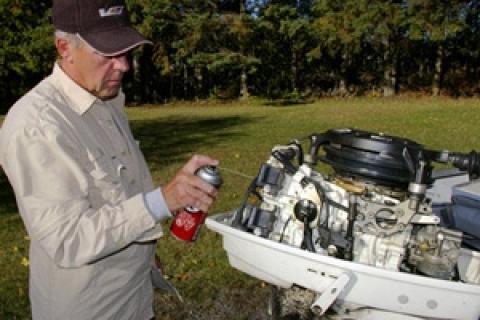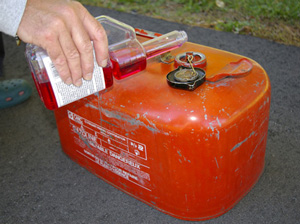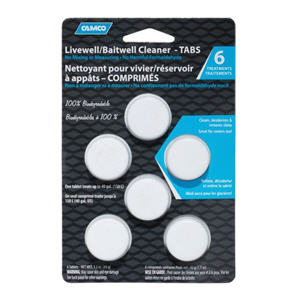
As the days grow shorter and winter's chill begins to take hold, the sad task of preparing the boat for its yearly hibernation has once again arrived. Winterizing your boat is a necessary step to protect your investment while in deep freeze; it's also a good way to ensure that your boat is running in tip-top shape once the season resumes. Although the task does take some know-how and effort, the end result — a boat that starts come spring — is most certainly worth it.
1. Starting the Process of Winterizing Your Boat, Trailer & Motor

preserve it throughout the winter months.
It is recommended that you consult your owner's manual for both boat and motor before beginning any winterization measures. Each may have some specific recommendations. If you don't feel confident with do-it-yourself tasks, please leave the process to a professional marine mechanic.
Tip: A good fuel-stabilizer is STA-BIL Fuel Stabilizer. This fuel storage stabilizer removes water to prevent corrosion, and cleanses carburetors and fuel injectors. It also protects your engine from gum, varnish, rust, and corrosion, and prolongs the life of any engine
Winterizing your boat follows a few simple rules that, for the most part, aren't too difficult. Take your time, double check your work and keep a checklist handy to mark off each job as it is completed.
Before getting into the nitty-gritty, give your boat, trailer and engine a good and thorough cleaning. This will remove the entire season's dirt, and will leave the boat sparkling clean when the cover is removed come spring. (Please see my feature guide, "Cleaning Your Boat from Top to Bottom," for helpful tips and tricks.)
First, remove the drain plug, and then raise the bow of the boat higher than the stern. Doing so will allow any water to trickle out, alleviating concerns about freezing liquid, which can crack the hull of your boat when the temperature plummets.

4-cycle engine. Keeps fuel
fresh for up to 12 months
during storage.
Remove all items from your boat, including boat seats, electronics, life jackets and vests and fishing equipment. Electronics, such as fish finders and trolling motors, should be stored inside. Emptying the boat will prevent items from getting wet and ruined, while also reducing the chances of animals building nests. I like to toss a handful of mothballs under the cover and into compartments to further deter pesky rodents.
With your equipment out of the boat, an inventory can be completed over the winter months to identify those items needing to be replaced or fixed. Check for holes and worn or broken parts.
Remove the batteries from the boat. Clean the terminals with a wire brush and a baking soda and water mixture, and then apply some petroleum jelly or grease to the terminals once they're dry. Check water levels and fill up if necessary. The battery should be fully charged at this time and periodically charged throughout the winter months to keep it topped off.
Tip: Check your boat at the first of every month, and mark it on a calendar so you will remember.
2. Winterizing the Outboard Boat Motor
Winterizing an outboard boat engine involves a few steps, but once learned, they aren't all that complicated. The first step is to fill up all gas tanks, which will eliminate moisture build-up over the winter months. Check hoses, bulbs and connectors and replace if leaks or deterioration is present.
Change the fuel filter and water separator; add a fuel stabilizer to the gas tank to ensure that the gas will be fresh come spring.

Attach a motor flusher to your garden hose and slide it over the water intake vents on the lower unit of the motor. While the water is running, start engine and allow it to idle for 15 minutes. This will ensure that adequate fuel stabilizer will get through the entire system. With the engine running, spray a fogging agent through the carburetors until smoke is visible from the exhaust and the motor kills. This oil will cover everything inside the motor, which decreases the chances of moisture occurring.
Four stroke engines should have the spark plugs removed and the fogging agent applied to the cylinder walls, spark plugs and pistons.
The flywheel (see owner's manual) should be spun a few times by hand in order to distribute the oil evenly.

silicone anti-corrosion spray to prevent
moisture from adhering to parts and doing
harm.
Check spark plugs for wear and tear. I prefer to keep the old plugs in during the winter and replace with new ones come spring. Make sure to gap them correctly when installing.
Coat the entire engine body with a silicone anti-corrosion spray. This will prevent moisture from adhering to parts and doing harm.
Drain the lower unit of oil, keeping a close eye out for a cloudy or milky appearance. If that is present, chances are you have a problem with your seals, it's best to consult a marine mechanic with this problem. If the oil seems fine, pump fresh oil in the lower screw hole until it seeps out of the upper screw hole. Replace top screw first, then the lower.

Cleaner Tablets
Remove the propeller and inspect for fishing line or weeds that may have become entangled along the shaft. If damage is evident on seals, they will need to be replaced. While the prop is off, give it the once over for cracks, bends or breaks. If wear is bad, replacing the unit or get it rebuilt. Coat the shaft with lube and replace prop.
3. Clean the Boat Bilges and Livewells
Bilges and livewells should both be thoroughly washed out and dried. If water does remain, it can freeze and lead to damage. A small amount of antifreeze can be added to both of these areas as a preventative measure, but antifreeze must be thoroughly washed out of the livewells before using them again.
Tip: Shop Camco Livewell / Baitwell Cleaner Tablets at Bass Pro Shops here
4. Inspect Your Boat's Hull
Now is the time to inspect the bottom and sides of your boat hull. Be on the lookout for cracks, damaged or missing rivets and weak joints. Minor damage can be a do-it-yourself project, but major damage will need the attention of a professional.
5. How to Prep Your Boat Trailer for Winter
The trailer is an important part of the winterizing process. I like to check all lights for water, drying them out completely. Pull the bulbs and give the sockets a small spray of a moisture repellent. Check the condition of the seals and replace light covers.

System
Inspect the wiring harness, trailer bunks and winch. Put a dollop of petroleum jelly on the connectors and cap them for the winter.
Jack up each wheel and give the tires a spin. If any sort of grating noise is heard, or if the tire is not running freely, chances are you have a bearing problem. This will need to be looked at more closely. If things seem good, pull the wheel assembly and clean and re-pack with fresh grease. Once the wheels have been put back on, top off the grease through the bearing protectors.
Check the the trailer tires for wear and proper inflation.
It is best to remove the wheels and store the tires inside, as this will protect them from the elements, as well as the "flat spots" that can occur when a trailer sits over time. Make sure you block the trailer first before beginning this step.
Jack the trailer up by raising the axels while keeping the springs in the load position — this is the correct way to go about storing your boat.
Tip: Shop boat trailer accessories at basspro.com here
6. Cover Your Boat
The boat should be well covered once all of the above steps have been completed. Start with the actual boat cover, then a series of poly sheets can be placed over top. Tie these down snugly, with rope and bungee cords, in order to get a tight and secure fit. Wind and the elements can get under a cover that leaves the smallest of drafts, so don't be afraid to take this step to the extreme.
Tip Watch Video: Shaw Grigsby's Simple, Easy Boat Cover Trick
As you can see, winterizing your boat isn't a tough job. I've covered the basics above, and this list should have you well on your way to giving your boat the proper rest it needs. And don't worry — spring is just around the corner!
Tip: Shop Boat Covers, Accessories and Biminis Tops at Bass Pro Shops here
- 64412 views

